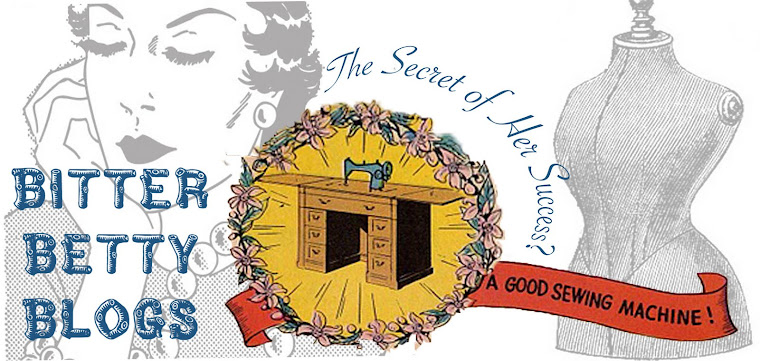See how crisp? How simply sophisticated? How subtly structured?
So Lily Pulitzer. So Mad Men. So Jackie O.
Many of the instructions I came across for this embellishment were a little vague. And I encountered a lot of frustration with sloppy, floppy piping protruding ungracefully from the seams of my garments on my early attempts.
I was beginning to wonder if every seam would need to be hand slipstitched into place, making cording a time intensive, possibly not worthwhile, fashion option.
So after much research and trial and error I will show you the easiest way I found to make a piped/corded seam that really fits, with items and tools you may already have around the house.
The Corded or Piped Seam Tutorial
You can buy corded bias trim piping (called Maxi Piping in these parts) or you can make your own.
Today I made my own blue piping by inserting some #16 (a little bit thin to be ideal) cotton twine into pre-made bias tape. I think a worsted weight or rug weight cotton yarn would also work well, however you'd want to do a quick color fastness check if it isn't a light neutral, or the same color as you bias tape.
I also cut and mitered bias strips of 1.25 inches in width and made patterned cording which could match or contrast with your main pattern pieces... Look, Flowers... Pretty!!
This strip was ironed wrong sides together to press in a center crease, then finished like the pre-made bias tape corded piping shown below.
The trick for a nice tight corded seam is all in the needle settings:
First determine if your needle has 3 positions right/ center /left. Mine are located with the stitch selections. If your machine has these options: Adjust to the left.
Use your zipper foot installed on the left side. Older machines may have a seperate left hand zipper foot.
Place the twine into the center crease of the bias tape and use zipper foot to baste it closed. Close it, but don't get too close to the cording. You will want this seam hidden when you insert the corded piping in your seam. I used a contrasting thread for demonstration but a thread that matches your bias tape is also a prudent idea.
The next step is to baste the corded piping to the right side of your project along the seam line you'd like piped. Corded edge facing the inside of the seam.
If you have tight corners, or curves you may want to clip and pin your piping in place like shown below:
Now that you're all basted pin the other piece of your project together, right sides facing.. or if you are lazy like me you can employ the pinch and pray method. This is what your layers should look like:
Next apply your stitch width adjustment. I adjusted mine from 6.5 down to 3, but I'm assuming that each application would vary somewhat.
Make the needle move closer to the cord until it is snuggled right up to it ( photo shows top layer removed to illustrate needle placement more effectively.)
Now with all layers in place use your fingers (Carefully! Please!) to guide the cording in the zipper foot notch. (photo shows an example that is previously been stitched to better illustrate the line you'll want to be following)
Now simply turn seam and press.
OoooH! Cute! Even before it's Pressed!
And here's a little practice project you could try. Just two 4 inch squares , finished with custom made corded piping and a button covered with the same fabric.
Mine is a smart little linen and lavender sachet! No Lavender? How 'bout a pincushion?
This skill can virtually transform your dressmaking!
Who doesn't love these smashing garment details?
Ooh Lala!
One last little tid bit about what to do at the ends of the cording from Talbot's Guide to Sewing:
and I'm off to finish the dress in the first picture.
Ciao Dolls!
Betty


















12 comments:
Thankyouthankyouthankyouthankyouthankyouthankyouthankyouthankyouthankyouthankyouthankyou!!!!!
I've been putting off a chair I wanted to recover because of this. Thanks. :)
Great work, Bethany! Very good tutorial.
Very useful! I have actually pondered such a thing on several occasions over the years--thanks!
Gotta go, the kids are yelling...no, laughing...no, yelling...
bye!
I have a top I've wanted to try this on - definitely bookmarking for future reference :)
It's all Greek to me, I'm afraid, but it looks great, Betty!
Excellent tutorial! Those books always flumoxed me when I was a youngster, too!
Ohhh how nice! I love trim effects that make a garment more finished and elegant without screaming TRIM! Thanks so much for the tutorial :-)
Super cute. I'll have to try it. Thanks for translating it into easy to understand instructions :)
Wow, this looks great. I love how polished it is. Thanks so much for the tutorial. I'll be linking.
I can't wait to recover my porch covers now.
you make it look so easy. Maybe when I get out of Diaper hell I can start using some of these more fancy techniques
I spent hours to figure this thing out by myself. Your tutorial is wonderful, thank you so much!
Post a Comment